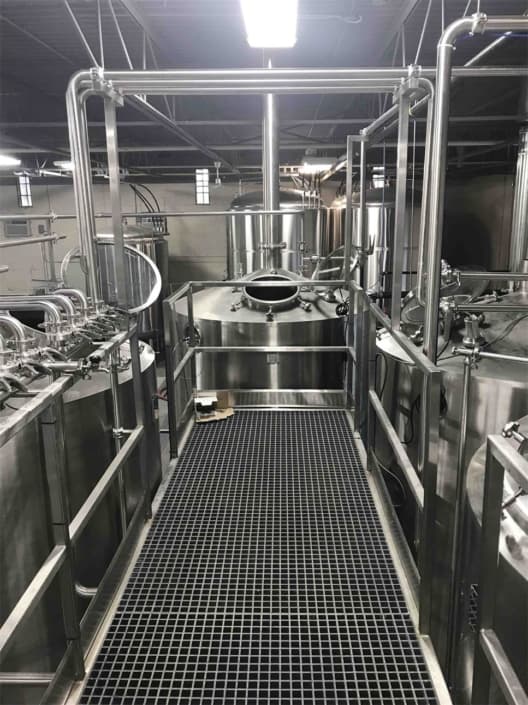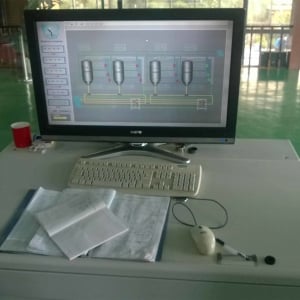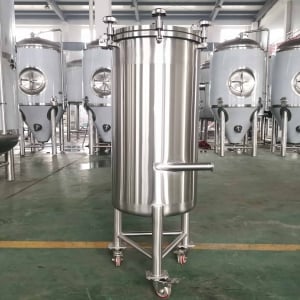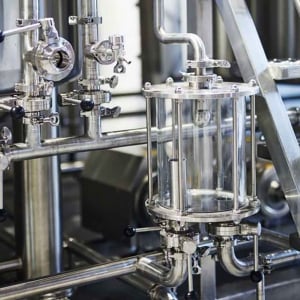5 BBL Jacketed Fermenters
A 5 BBL Jacketed Fermenter is a critical piece of equipment for intermediate-scale craft breweries producing 1,500-3,000 barrels annually. This stainless steel vessel with temperature controlled outer jacket allows efficient fermentation of 5 barrels (155 gallons) of wort into beer. We elaborate specifications, designs, suppliers, prices, installation, operation, maintenance of 5 BBL Jacketed Fermenter to help brewers make the right equipment choice.
5 BBL Jacketed Fermenter Equipment Guide
This table summarizes key details about 5BBL jacketed fermenters:
| Parameter | Details |
|---|---|
| Function | Fermentation vessel to convert brewer’s wort into beer |
| Capacity | 5 barrels or 155 gallons |
| Construction | Stainless steel (304 or 316 grade) |
| Shape | Cylindrical or conical |
| Jacket design | Welded outer jacket with 2-4 inch annular space for glycol/water cooling |
| Operating temperature | 32-75°F (0-24°C) |
| Pressure rating | 15 PSIG maximum |
| Agitation | Impeller or paddle mixing system |
| Glycol/water system | External cooling unit recirculates chilled fluid in jacket |
| Controls | Digital temperature controllers, gauges, valves, switches, sample ports |
| Support systems | Stands, platforms, stairs for top access hatches |
| Compliance | ASME, OSHA, UL/ETL, 3A (sanitary) |

Types of 5 BBL Jacketed Fermenter
5BBL fermenters come in two primary configurations – cylindrical and conical:
Cylindrical:
- Traditional straight-walled vessel with hemispherical heads
- Manual/automatic bottom draining
- Top or side harvesting manway
- Difficult yeast handling without cone
Conical:
- Angled cone bottom with yeast dump valve
- Promotes sedimentation for cleaner beer
- Ergonomic bottom harvest port
- More expensive than cylinder
Hybrid:
- Mix of cylinder and cone
- Conical bottom, straight walls
- Compromise design for cost savings
Specialty shapes:
- Horizontal configurations
- Non-standard dimensions
- Custom tanks possible
5BBL Fermenter Design Elements
Key design elements that impact performance, convenience and budgets:
| Element | Options | Considerations |
|---|---|---|
| Inner shell | 304 or 316L stainless | 316L better corrosion resistance for sour beers |
| Finish | Inside: polished, electropolished <10Ra | Smoother surfaces resist bacteria |
| Outer jacket | TIG welded separate chamber | No exposed welds touching beer |
| Rotation system | Direct drive, gear drive, chain drive | Slow rpm for gentle agitation; adjustable impeller height |
| Stands | Adjustable feet on frames | Flexibility for unloading; seismic anchoring |
| Manways (access ports) | Top and side tunnels with doors | Convenience for loading, unloading, cleaning |
| Harvesting system | Bottom valve or racking arm | Minimize oxygen uptake; sanitary tri-clamp connections |
| CO2 purge | Blanketing during transfers | Prevent oxidation especially for hoppy styles |
| Sample valve | Extract mid-fermentation samples | Ensure quality, gravity without opening vessel |
| Sight/light glass | View yeast behavior and clarity | Borosilicate or stainless constructions |
| Thermowell | Monitor internal temp | Critical to control fermentation temperature |
| Pressure relief | Burp the tank; vent excess CO2 | Safety release valve |
| Stand pipe Internal dip tube Maintains liquid level for blowoff Prevent overflow contamination | ||
| Variable speed drives | Precise impeller agitation control | Optimize mixing for each yeast strain |
| Flow meters | Monitor glycol/water flow rates | Detect fouling; balance cooling across banks |
| CIP sprayball | Interior spray cleaning | Automated cleaning saves enormous labor |
5 BBL Jacketed Fermenter Suppliers
Many tank fabricators offer 5BBL jacketed fermenters in stock or custom designs. Budget $10,000 to $50,000 depending on features.
| Company | Base Price Range | Offerings |
|---|---|---|
| JV Northwest | $10,000 to $15,000 | Standard cylindrical and conicals; budget-friendly |
| SS Brewtech | $12,000 to $20,000 | UniTanks; modular upgrades available |
| Rietschle Brewart | $15,000 to $25,000 | Custom conicals for craft breweries |
| AAA Metal | $16,000 to $35,000 | Custom dimensioned feature-rich conicals |
| Psychosomatic | $20,000 to $50,000 | High-precision build; extreme customization |
| American Beer | $25,000 to $45,000 | Widest selection; innovative features |
| Premier Stainless | $30,000 to $60,000 | Top-tier manufacturing; industry leaders |
Many more suppliers exist across the country and abroad. Get multiple quotes before purchase comparing warranty, lead times, specific options and freight terms.
Installation Considerations
Proper installation of a 5BBL fermenter requires planning electrical, plumbing, glycol and sanitary connections:
| System | Requirements | Specs |
|---|---|---|
| Electrical | 208-480V, 3 phase circuit | Size breaker for cooling unit, agitator load |
| Plumbing | Potable cold water inlet | 1⁄2” NPT min for CIP sprayball |
| Plumbing | Floor drain near unit | 2” drain for blowoff, drainage, overflows |
| Glycol | Supply and return recirc lines from chiller | 1” flexible hoses with camlocks |
| Sanitary | Tri-clamp fittings on harvest path | 1.5”-2” ID smoothbore tubing |
| Ventilation | Roof jack with fan | Avoid pressure buildup; positive air pressure |
| Platform | Stairs for top hatch access | Safety rails; 5ft platforms typical |
Ideally locate centrally in brewhouse near mill room for easy raw material handling. Allow 3ft clearance all around tank for service access. Install seismically anchored stands adjustable for unloading.
5 BBL Jacketed Fermenter Operation
Following SOPs for filling, fermenting, transferring and cleaning are critical:
| Parameter | Guidelines | Tips |
|---|---|---|
| Filling | 150-160°F pre-boiled wort with yeast | Pump slowly to avoid aeration |
| Fermentation | 48-72 hours typical duration | Adjust temp ±2°F for ideal attenuation |
| Agitation | Brief mixes 2-3 times daily | Let sediment settle before harvesting |
| Transfer | Drain yeast first then clear beer | Purge headspace with CO2 when empty |
| Cleaning | Hot detergent cycle every turn | Soak filters/screens in caustic bath |
| Wetting | Glycol below dew point before filling | Prechill to pitching temp; thermal shock ruins stainless |
| Sampling | Pull 1-2 oz mid-fermentation | Adjust recipes tracking gravity drop |
| Recordkeeping | Log all fills, temps, attenuation | Identify trends; improve processes |
5 BBL Fermenter Maintenance
Preventative maintenance protects your investment:
| Task | Frequency | How |
|---|---|---|
| Inspect seals | Monthly | Replace cracked door seals |
| Lubricate parts | Monthly | O-ring safe lubricants on shafts, rams |
| Check insulation | Annually | Repair dings; replace if moldy |
| Test safety relief valves | Annually | Manual actuation to avoid sticking |
| Inspect jacket | Annually | Leaks indicate foulants or corrosion |
| Clean glycol strains | Quarterly | Inspect chiller heat exchanger interior |
| Delime spray balls | Quarterly | Soak CIP heads in acid solution |
| Calibrate sensors | Annually | Ensure accurate temp control |
| Check welds | Annually | Crack test carbon steel stands every 3yr |
Choosing a 5BBL Fermenter Vendor
Use this scorecard when evaluating suppliers:
| Criteria | Weight | Notes |
|---|---|---|
| Build quality | 10 | Welds, surface finish, dimensional accuracy |
| Features | 10 | Assess usefulness of offerings |
| Configurability | 5 | Flexibility for future expansion needs |
| Lead time | 10 | Schedule with expansion projects |
| Shipping terms | 5 | Inland freight? Liftgate fees? |
| Install support | 10 | On-site or remote guidance? |
| Warranty | 10 | At least 1 year; inspections required? |
| Service ability | 15 | Response time, technician expertise, parts access |
| References | 10 | Talk to their existing customers |
| Brand reputation | 15 | Google for complaints and praise |
Comparing 5 BBL Jacketed Fermenter Designs
| Parameter | Cylindrical | Conical | Hybrid |
|---|---|---|---|
| First cost | $ lowest | $$$ higher | $$ moderate |
| Yeast settling | Requires harvesting manifold | Sediments into cone for easy draw-off | Some cone settling action |
| Agitation effectiveness | Varies; foaming possible | Excellent utilizng cone bottom shape | Better than cylinder |
| Difficulty cleaning | Manual scrubbing needed | CIP rinses cone thoroughly | Moderate ease of cleaning |
| Ergonomics | Challenging side/top entry | Convenient bottom access | Side entry still requires climbing |
| Flexibility | Fully customizable dimensions | Constrained cone angles limit customization potential | Hybrids can be customized |
| Footprint efficiency | Very compact lengthwise | Consumes more floorspace with cone base | In between on space efficiency |
| Transfer flexibility | Usually just one racking arm | Often both top and bottom sample/drain valves | Side access hatch provides alternative transfer point besides bottom |
Key Advantages of 5 BBL Jacketed Fermenter
- Efficient fermentation temperature control
- Gentle agitation optimizes yeast activity
- Conical settling for cleaner beer transfers
- ASME certified construction for safety
- Automated cleaning minimizes risk
- Sample extraction ports simplify tracking
- Industrial components ensure reliability
- Scalable to add more tanks
- Excellent fermentation environment
Limitations of 5 BBL Fermenter Systems
- High first costs ranging $15,000 to $40,000
- Heavy weight requires reinforced mezzanines
- Access hatches in awkward places for short brewers
- Glycol cooling wasteful versus steam heating
- Manual data logging without automation
- Subject to thermal shock cracking if careless
- Difficult modification after fabrication
- Very long lead times presently for custom units

FAQ
What is the typical footprint of a 5BBL fermenter system?
A 5BBL fermenter with platform occupies approximately 6ft x 6ft of floorspace. The tank itself is around 5ft diameter by 8ft straight side height plus the conical base section. Leave 3ft clearance on all sides for service access.
What temperature controls should I plan for in the brewery?
Provide 15-20°F of glycol temperature differential below your lowest fermentation temperature. For example, if fermenting lagers at 50°F, size the chiller cooling capacity to reach 30-35°F supply temperatures. Utilize redundant systems for critical processes.
How long should I expect glycols to last in a brewery?
With proper fluid maintenance replacing strains annually, mechanical cleaning every quarter, and annual deliming of jacketed equipment – brewers typically achieve 4-6 years of continuous operation before full system flushes become necessary.
Should I insulate small fermenters?
While insulation theoretically saves cooling costs for heavily utilized tanks, small systems may not recover the upfront expense during their lifespan. Focus resources instead on higher efficiency chillers, variable speed drives, and upgraded controllers for the best payback.
What are the most important characteristics brewers look for in a fermenter?
Brewers rate quality of welds, surface finish, ease of cleaning, durability, precise temperature control, gentle mixing, and advanced process monitoring capabilities as top criteria when selecting a fermenter.
How many turns can a brewery expect to get yearly from a 5 BBL fermenter?
Based on average 12 day fermentation cycles including cleaning, a conservatively operated 5BBL fermenter might achieve 20-25 annual turns. At higher utilizations with faster yeast and minimal aging, upwards of 30 turns are feasible. This translates to 500-750 annual barrels output per 5BBL vessel.
Should I choose 304 or 316 stainless for my fermenters?
304 stainless steel offers adequate corrosion resistance for most clean beer styles at significant cost savings versus 316 steel. For sours, wilds, and extreme ingredient/adjunct recipes – upgrade to 316L construction for maximum chemical compatibility. Electropolished interior finish also helps withstand acidic worts and prevent bacteria establishment.
What are the most critical operation and maintenance concerns for fermenters?
Taking care to thoroughly CIP clean after each turn, lubricate door seals and access points regularly, promptly address any leaks or damage, calibrate sensors annually, and monitor glycol fluid conditions goes a long ways towards reliable performance and extended service life. Technicians must receive thorough training for all vessels.













